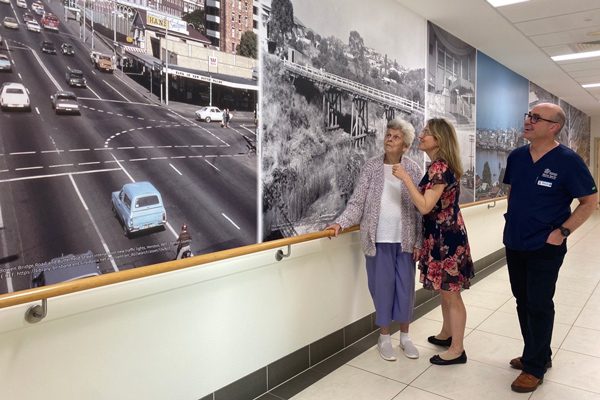Memory lane helping older patients speed up road to recovery

Patient Eileen takes a walk through Memory Lane with hospital staff members, Dr Lucy Dakin and Kevln Clark
Patients and their families can now walk through the recently completed ‘Memory Lane,’ a hospital corridor adorned with images from yesteryear.
The impressive photographic display showcases the rich history of Brisbane and The Prince Charles Hospital with imagery including the 1982 Commonwealth Games and its mascot Matilda, and the Royal visits of Queen Elizabeth II in 1954, and Prince Charles in 1994 to The Prince Charles Hospital.
There is also a range of pictures of local landmarks under construction such as Houghton Highway, Lang Park (now more commonly known as Suncorp Stadium) and the Story Bridge.
The initiative was the result of several months of consultation between staff of TPCH’s Internal Medicine Service and The Common Good, an initiative of The Prince Charles Hospital Foundation who supported the project.
It is designed to benefit the many older patients who are admitted to the wards surrounding the corridor by giving them a reason to get out of bed, remain mobile and stay cognitively engaged.
TPCH Director of Geriatrics and Subacute Services Dr Lucy Dakin said that for many older patients, staying active and maintaining their strength and balance can be difficult while in hospital.
“Older patients are at greater risk of functional decline, as hospital-associated deconditioning tends to happen at a faster rate for them,” Dr Dakin said.
“We know that older people who are lying in bed often can’t regain their independence and face a lot of obstacles to their recovery.
“Giving them motivation and a reason to get out of bed helps them to improve that independence and promotes a faster recovery.
“The new Memory Lane encourages patients to stay mobile by providing them with an appealing walking destination and a nostalgic experience.
“It’s about providing patients with a functional and engaging recovery environment so they return home sooner with independence.
“Memory Lane is a fantastic initiative for patients and families – we’ve had patients and visitors from all over the hospital coming to take a look. It’s a real point of connection.”
